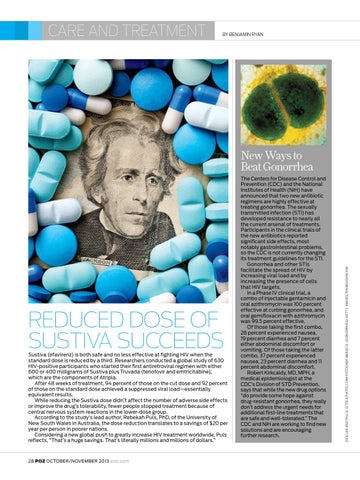CARE AND TREATMENT
BY BENJAMIN RYAN
REDUCED DOSE OF SUSTIVA SUCCEEDS
Sustiva (efavirenz) is both safe and no less effective at fighting HIV when the standard dose is reduced by a third. Researchers conducted a global study of 630 HIV-positive participants who started their first antiretroviral regimen with either 600 or 400 milligrams of Sustiva plus Truvada (tenofovir and emtricitabine), which are the components of Atripla. After 48 weeks of treatment, 94 percent of those on the cut dose and 92 percent of those on the standard dose achieved a suppressed viral load—essentially equivalent results. While reducing the Sustiva dose didn’t affect the number of adverse side effects or improve the drug’s tolerability, fewer people stopped treatment because of central nervous system reactions in the lower-dose group. According to the study’s lead author, Rebekah Puls, PhD, of the University of New South Wales in Australia, the dose reduction translates to a savings of $20 per year per person in poorer nations. Considering a new global push to greatly increase HIV treatment worldwide, Puls reflects, “That’s a huge savings. That’s literally millions and millions of dollars.”
The Centers for Disease Control and Prevention (CDC) and the National Institutes of Health (NIH) have announced that two new antibiotic regimens are highly effective at treating gonorrhea. The sexually transmitted infection (STI) has developed resistance to nearly all the current arsenal of treatments. Participants in the clinical trials of the new antibiotics reported significant side effects, most notably gastrointestinal problems, so the CDC is not currently changing its treatment guidelines for the STI. Gonorrhea and other STIs facilitate the spread of HIV by increasing viral load and by increasing the presence of cells that HIV targets. In a Phase IV clinical trial, a combo of injectable gentamicin and oral azithromycin was 100 percent effective at curbing gonorrhea, and oral gemifloxacin with azithromycin was 99.5 percent effective. Of those taking the first combo, 28 percent experienced nausea, 19 percent diarrhea and 7 percent either abdominal discomfort or vomiting. Of those taking the latter combo, 37 percent experienced nausea, 23 percent diarrhea and 11 percent abdominal discomfort. Robert Kirkcaldy, MD, MPH, a medical epidemiologist at the CDC’s Division of STD Prevention, says that while the new drug options “do provide some hope against drug-resistant gonorrhea, they really don’t address the urgent needs for additional first-line treatments that are safe and well-tolerated.” The CDC and NIH are working to find new solutions and are encouraging further research.
(DOLLAR AND PILLS) ISTOCKPHOTO.COM/FOTOGRAFIABASICA; (GONORRHEA) GETTY IMAGES/KWANGSHIN KIM
New Ways to Beat Gonorrhea
28 POZ OCTOBER/NOVEMBER 2013 poz.com
P10-13p28,29.CARE_TREATMENT_HY.indd 28
8/19/13 10:08 PM POZ845-00_P028.pgs 09.06.2013 17:31
